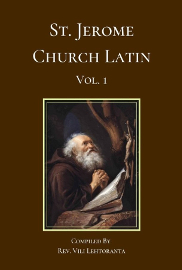St. Jerome Church Latin: Vol. 1 presents a challenging two-year course for Latin that is appropriate for Catholic high school students. The textbook covers all five noun declensions and all four verb conjugations. Lesson plans for each year (available from the publisher) lay out a 36-week course of study that includes the use of the textbook, the St. Jerome Church Latin: Workbook 1, and Officium Parvum Sanctae Crucis for additional reading and prayer. While some students might be able to complete the textbook in one year, the pace will probably be too rapid for most students to do so. (St. Jerome Library bundles this two-year course into their tenth- and eleventh-grade programs as Latin I and Latin II.)
The book’s author, Father Vili Lehtoranta, discusses in a preface the value of learning the pronunciation and vocabulary of Latin used by the Catholic Church. His remarks include occasional comments that reflect his support for the Latin Mass and a pre-Vatican II perspective. In the preface, he also explains Latin pronunciation, syllables, and accent marks.
The publisher says on the website that the material was “compiled from many classical and out-of-print sources used in Catholic schools before the reforms of the Vatican Council II.” So material related to the Mass is from the Latin Mass rather than the Novus Ordo Mass.
There are 86 lessons in all, and the first lesson jumps right in by teaching both singular and plural forms for all five cases of the first declension.
A 38-page Latin-English dictionary near the back of the book covers the many vocabulary words taught in the course. Another 67-page section has charts with summaries of the conjugations, declensions, and pronouns. Since the text has only 300 pages, you can see that a significant portion of the book is reference material.
The lessons themselves are succinct in their presentation. A concept is explained, an example is presented, new vocabulary words are given, then students are given exercises to practice. Students will frequently need to spend some time studying and memorizing lesson content. Some lessons cover a lot of material and will take quite a bit of time to complete. Some briefer lessons introduce new vocabulary but no new grammar concepts, while others teach only a new grammar concept but no new vocabulary.
Instructional information or new vocabulary is followed by an exercise set with an average of about 20 Latin sentences to be translated into English. The courses require only Latin to English translation. Students can work directly from the textbook to write their translations for the exercises into a notebook, but the St. Jerome Church Latin: Workbook 1 lays out the exercises so they are easier to read and provides space for students to write their translations.
Many lessons include passages for reading practice that were drawn originally from the readings for the Latin Mass, prayers, stories of saints, and historical books. The content of the readings is mostly religious, but there are a few passages that are secular. Some lessons have students translate a Latin proverb and explain its meaning. The proverbs present historical and cultural insights that students are likely to appreciate.
A supplementary book, Officium Parvum Sanctae Crucis: The Little Office of the Holy Cross, is optional. This 32-page book has some of the prayers, hymns, and responses for the Liturgy of the Hours—all in Latin. Students can use these both for reading practice and for prayer.
An answer key has the translations for all of the workbook exercises. There are no tests.
Summary
St. Jerome Church Latin: Vol. 1 should work well for students who know how to study on their own. They will need to spend time memorizing vocabulary, conjugations, and declensions without any specific directions in the text or workbook telling them to do so. Parents can use the lesson plans to help with pacing for the course, but they might need to adjust the timing to suit each student.








